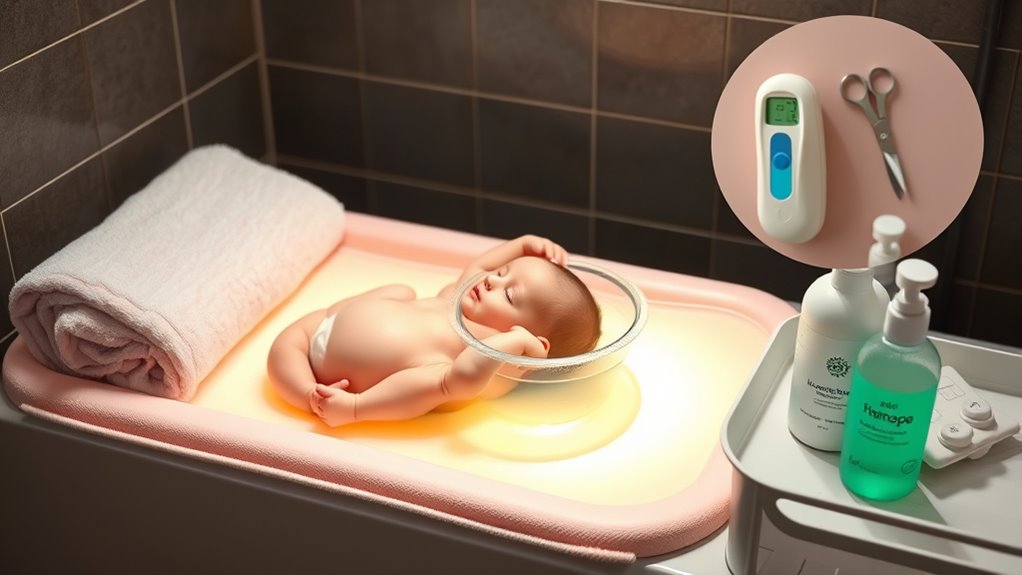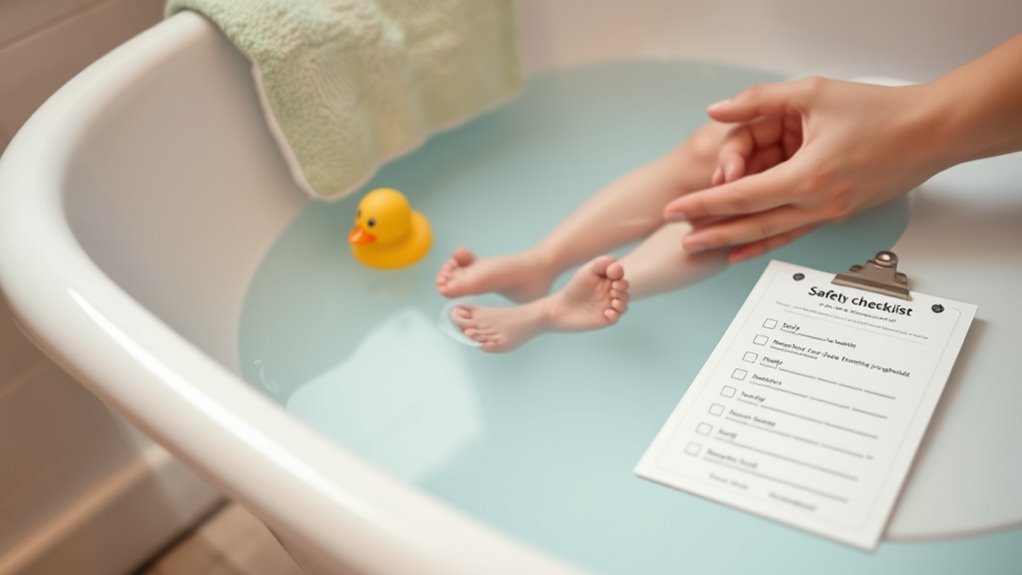To guarantee safe baby bathtimes, gather all supplies beforehand and keep them within arm’s reach. Always test water temperature with your wrist or elbow—never rely solely on the tap setting—and fill the tub with just 2-3 inches of warm water. Never leave your baby unattended, hold them securely, and use gentle motions. Afterward, dry your baby thoroughly and keep them warm. For more detailed safety tips, continue exploring essential guidelines to keep your baby safe and comfortable.
Key Takeaways
- Always supervise your baby during bath time; never leave them unattended, even for a moment.
- Check water temperature with a thermometer or your wrist to ensure it’s comfortably warm (90-100°F).
- Keep all bath supplies within arm’s reach to prevent leaving your baby unattended.
- Use shallow water (2-3 inches) to reduce drowning risk and support your baby’s head and body securely.
- Pat dry skin gently, especially in folds, and keep your baby warm and dry immediately after bathing.
Essential Baby Bathtime Safety Tips

Bathing your baby can be a calming and enjoyable experience, but safety should always come first. Before you even start, gather everything you’ll need—like a soft washcloth, gentle baby soap, a clean towel, and a thermometer to check the water temperature. Having everything within arm’s reach helps prevent you from leaving your baby unattended, even for a second. Never leave your baby alone in the bath, no matter how brief. Accidents can happen quickly, and a moment of distraction could lead to a fall or drowning risk.
Always check the water temperature before placing your baby in the bath. Fill the tub with just a few inches of warm water—around 90 to 100 degrees Fahrenheit. Use your wrist or the inside of your elbow to test the temperature; it should feel comfortably warm, not hot. Never rely solely on the water heater’s setting, as it can vary and sometimes be unsafe. Keep the water level shallow to minimize the risk of slipping or drowning. Remember, babies can drown in just a few inches of water, and even a small amount of water can be dangerous if they slip under.
As you prepare to bathe your baby, ensure that the room is warm and free from drafts. This keeps your little one comfortable and prevents chills. Keep all supplies close at hand so you don’t have to step away during the bath. Hold your baby securely at all times—cradle their head and neck with one arm while supporting their body with the other. Use gentle, soothing motions, and avoid sudden movements. Never shake or jerk your baby, even if they cry or squirm. Be mindful of their delicate skin—use mild, fragrance-free soap and avoid scrubbing too hard. Additionally, proper water temperature is crucial to prevent discomfort or burns.
After the bath, immediately wrap your baby in a soft towel, covering their head to keep them warm. Gently pat them dry, paying special attention to skin folds where moisture can cause irritation. Keep an eye on your baby’s temperature and behavior—if they feel cold or start to shiver, add an extra blanket or warm them up gently. Once dry, apply a gentle moisturizer if needed, and dress your baby in clean, comfortable clothes. This routine not only keeps your baby safe but also makes bath time a soothing bonding moment. Remaining attentive and prepared ensures that each bath is safe, calm, and enjoyable for both of you.
Frequently Asked Questions
How Do I Know if the Water Temperature Is Safe for My Baby?
You can verify the water temperature is safe for your baby by testing it with your wrist or elbow, where the skin is more sensitive. The water should feel warm but not hot, ideally around 100°F (38°C). Always check before placing your baby in the bath, and consider using a bath thermometer for accuracy. This way, you prevent burns and make bath time safe and comfortable.
What Should I Do if My Baby Slips During Bath Time?
If your baby slips during bath time, stay calm and immediately support their head and body to prevent injury. Gently lift them out of the water and dry them thoroughly. Check for any signs of injury or discomfort, and comfort your baby with soothing words. Always keep a firm grip on your baby, never leave them unattended in the bath, and make certain the surface is non-slip to prevent future slips.
Are There Safe Bathing Products Suitable for Newborns?
Did you know that over 80% of accidents during bath time involve slips or falls? You should choose gentle, fragrance-free products specifically formulated for newborns. Look for items labeled “hypoallergenic” and “pH-balanced” to safeguard your baby’s sensitive skin. Always test a small amount first, and avoid harsh soaps or shampoos with added dyes or fragrances. Your careful selection helps guarantee safe, soothing baths for your little one.
How Often Should I Bathe My Baby to Ensure Safety?
You should bathe your baby about two to three times a week to keep them clean and healthy, without risking dry skin. On non-bathing days, gently wipe their face, neck, hands, and diaper area with a damp cloth. Always monitor your baby during baths, verify the water is warm but not hot, and never leave them unattended. This routine promotes safety and comfort for your little one.
What Are Signs of Discomfort or Distress During Bath Time?
During bath time, you should watch for signs of discomfort or distress, like crying, fussiness, or struggling. If your baby suddenly becomes tense, turns away, or pushes away, stop immediately. Keep an eye on their facial expressions—if they look scared or upset, it’s time to pause. Remember, fussing is normal, but persistent distress indicates they’re uncomfortable. Always stay close, support their head, and respond calmly to soothe them.
Conclusion
Now that you know the key safety tips, you’re well-equipped to make bath time safe and stress-free. Remember, safety isn’t just about checking off items on a list—it’s about staying alert and attentive every step of the way. Keep your wits about you, because when it comes to your little one, an ounce of prevention is worth a pound of cure. With a little care, bath time can be a joyful, worry-free moment for both of you.









